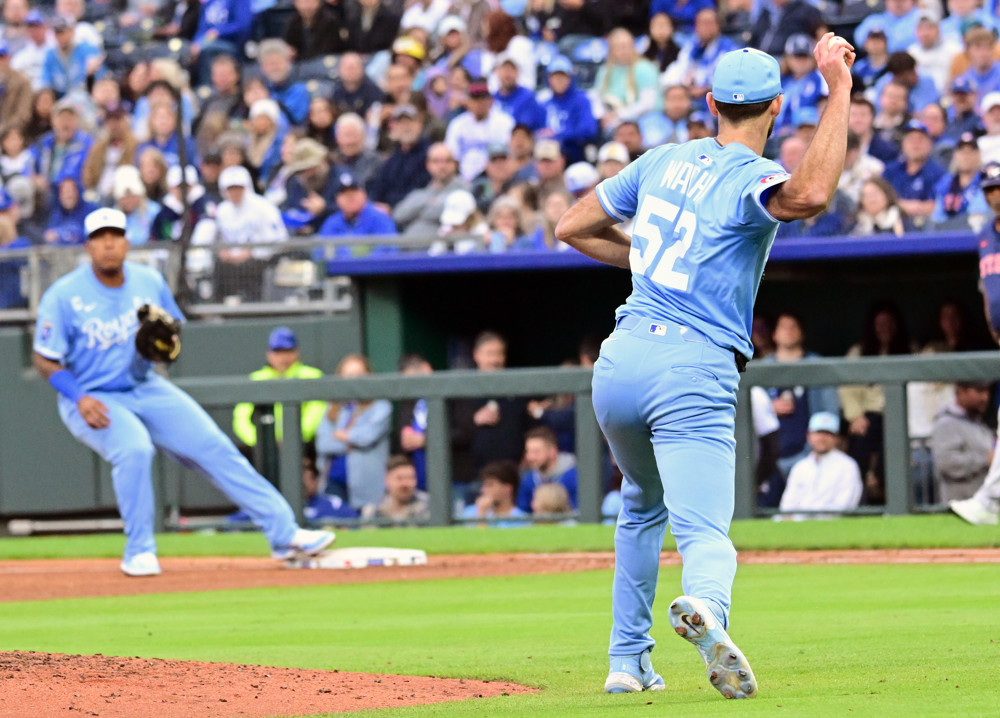Assuming Jerry Reinsdorf only helps those who help themselves -- and Chris Getz's comments at the GM meetings suggest the White Sox roster will not receive a surge of outside talent despite three consecutive 100-loss seasons -- pitcher defense is the second-most direct place to get started.
Strikeouts would be simplest, of course. But those cost money, so attention turns to the smattering of opportunities for pitchers to create the other kinds of outs that minimize the involvement of others. Every assist instantly deposits an out into their account, and every base prevented makes it harder to put a run on their tab.
This is one of the reasons why the White Sox tapped Zach Bove to be their pitching coach, coming off three years as the assistant pitching coach with the Royals. Over the past two years, Kansas City's starting pitchers have posted a 3.67 ERA, which is one-hundredth of a run behind Seattle for the league lead. It's quite an accomplishment considering that Cole Ragans is the only true strikeout maven on the staff. With him, their K-rate (22.4 percent) is within a rounding error of the league average (21.9). Remove Ragans from the equation -- and a strained rotator cuff effectively did that job for most of 2025 -- and that K rate drops to 20.8, which is in White Sox territory. And yet, the rotation's cumulative ERA only rises one-tenth of a run to 3.77 without Ragans, which would still be good enough for the fourth-best mark in the league.
The gloves of their arms have been a noteworthy component of their run-prevention efforts. Over the past two years, they've leveraged pitcher defense -- and specifically holding runners -- in a way that stands out from the rest.
ROYALS PITCHER DEFENSE
| Year | DRS | Rank | SB | CS | CS% | Rank |
|---|---|---|---|---|---|---|
| 2021 | -7 | 25 | 41 | 24 | 37 | 1 |
| 2022 | 3 | 7 | 58 | 25 | 30 | 5 |
| 2023 | 12 | 2 | 105 | 26 | 20 | 12 |
| 2024 | 21 | 1 | 58 | 28 | 33 | 1 |
| 2025 | 15 | 2 | 47 | 23 | 33 | 1 |
Royals pitching staffs have ranked first or second in Defensive Runs Saved the last three years, and nobody comes close to preventing stolen bases like the Royals do. They have allowed a total of 105 steals the last two seasons, and Detroit is second ... with 178. Putting it another way, the gap between first and second is the same size as the gap between second and 22nd.
This stands in sharp contrast to what the White Sox have been doing in those departments over the last five years.
WHITE SOX PITCHER DEFENSE
| Year | DRS | Rank | SB | CS | CS% | Rank |
|---|---|---|---|---|---|---|
| 2021 | -13 | 30 | 119 | 24 | 17 | 30 |
| 2022 | -10 | 28 | 96 | 26 | 21 | 24 |
| 2023 | -15 | 30 | 170 | 35 | 17 | 30 |
| 2024 | -2 | 15 | 139 | 37 | 21 | 24 |
| 2025 | -10 | 27 | 147 | 31 | 17 | 26 |
So it makes a lot of sense for the White Sox to explore this territory while they wait for the strikeouts to arrive. Enter Bove, who was asked about pitcher defense in his introductory media session.
"It’s a huge component, right?" Bove started. "Obviously certain parts of the game - pitch shapes, deliveries, that I’m extremely passionate about. But those little details are extremely important, the running game, fielding your position.
"[I] was kind of exposed to some really unique things that the Royals did. Can’t take credit for it all, it was really a team approach from different areas. If you dive into the Royals the past couple of years, just how good they were at defensive runs saved, fielding your position and limiting stolen bases and all that stuff. There’s definitely some things I learned there that I’m excited to bring here to the White Sox."
And indeed, some elements can probably be imported. Mark Simon of Sports Info Solutions talked to Royals pitching coach Brian Sweeney about their efforts toward the end of a record-threatening 2024, and he said it started with drills in spring training:
“They’ve covered first a million times, they’ve turned double plays,” said pitching coach Brian Sweeney. “Can we make it fun?”
The following spring, Anne Rogers of MLB.com detailed some of those "really unique things" that Bove referenced:
Before Cactus League games started, every PFP drill the Royals had during their morning workouts usually featured a competition. One included a net set up at first base with nine pockets in it, and pitchers were instructed to hit their target on pickoff throws. If a ball landed in the top middle box, that was three points. The other boxes were worth two points. Missing the net entirely meant zero points and some light-hearted jeers.
Covering first, fielding bunts on the first-base side and third-base side, and even setting up at shortstop or second base to turn double plays and get used to different arm angles were all turned into competitions.
Some weren’t really related to fielding, just keeping the pitchers athletic, like when they had to field a ball and then shoot it into a bucket behind the mound. Bonus points were added if they did a hook shot. Another was using a fungo bat and seeing who could hit a ball closest to a cone set up in the shortstop area.
Simon's article also references the work on the running game, with Sweeney talking about eliminating tells from the stretch, and there's reason to think that Bove can impart some of those lessons on White Sox pitchers, who could use help in just about every aspect of self-defense.
But while the Royals did improve drastically, a lot of their improvement came from a couple of sources that aren't yet available to the White Sox.
For instance, one of the reasons opponents ran wild on the White Sox was their lack of left-handed pitching. Southpaws (mostly Martín Pérez) accounted for only 71⅓ innings of starting pitching in 2025, the fourth-lowest total in the league, while the Royals finished ninth with 339⅔. Left-handedness alone doesn't ensure steal suppression -- Garrett Crochet didn't have to care about runners going 17-for-18 on him in 2024 -- but it provides a head start of sorts. That wasn't available to the White Sox last year, and might not be until Noah Schultz and Hagen Smith arrive. (Even then, Smith is no stranger to allowing huge jumps, but that's a post for another time.)
There's also the matter that the Royals paid to bolster this skill set. They invested in the rotation before the 2024 season by signing Seth Lugo to a three-year, $45 million contract, and Michael Wacha for two years and $32 million. Both pitchers excelled at holding runners by right-handed standards before joining the Royals, and they continued to thrive in that department in Kansas City. They may have taken it up a notch with KC's newfound methods -- Lugo won the Gold Glove in 2024 -- but the Royals mostly maximized assets that were already on hand.
If you're looking for evidence that rightpaws can learn new tricks, Brady Singer is the most significant place to look.
- 2023: 0 DRS, 11 steals in 14 attempts
- 2024: 3 DRS, 3 steals in 9 attempts
Then again, Singer benefited from pitching to the tandem of Sal Perez and Freddy Fermin. Perez has the reputation that five Gold Gloves afford, while Fermin actually played Glove Glove-caliber defense in 2024, thwarting a whopping 45 percent of stolen-base attempts. The White Sox do not possess that kind of catching talent at present, although maybe Kyle Teel can get there in time.
Hypotheses will have to wait until Getz assembles the first draft of the 2026 rotation, much less conclusions, but he might have inadvertently directed his attention to an unflattering aspect of his approach with what he said on Wednesday ...
"Look at other teams that were in similar positions to ours in the last couple years that have taken significant jumps and how they went about it," Getz said. "Modeling after those clubs, that will dictate a pathway for us. The primary focus remains the continued development of these young players, without question. And that fundamentally is the right thing to do, I believe that. Now, in terms of protecting some of these players and creating depth, tapping into the free agent market might be the right decision as well."
... because the Royals, with the pitching staff we've been discussing and the assistant pitching coach the White Sox just hired, spent a significant sum of money at the very juncture the Sox have reached. They lost 88, 94 and 106 games from 2021 to 2023, and then they signed Wacha and Lugo while extending Bobby Witt Jr.
For all of that work, they only projected to win 73 games per ZiPS, and 71 per PECOTA. They ended up winning 86 games in 2024, a 30-win improvement which put them in the postseason, where they upset the Orioles in the Wild Card Series before losing in four games to the Yankees in the ALDS. A Bradford Doolittle article for ESPN that April explained why the Royals struck when they did, and among the things the White Sox have in common:
An encouraging second half: The Royals finished the 2023 season with a .423 winning percentage; the 2025 White Sox played .431 ball after the break
An encouraging run differential: The 2023 Royals had a Pythagorean record eight games better than their actual finish; the White Sox underperformed by 11 games.
Real estate dreams: The Royals were upping their efforts to drum up support for a publicly financed ballpark downtown, which sounds familiar.
What the White Sox don't have is a singular difference-making talent on the level of Bobby Witt Jr., who was a unanimous MVP runner-up to a unanimous MVP in Aaron Judge, and that admission is enough to keep the comparison from getting carried away. At the same time, had JJ Piccollo not spent John Sherman's money into 70-win territory, Witt's breakout would have been the lead story of an eighth consecutive losing season, rather than the star attraction of a shocking postseason run.
For these reasons, you'd think you'd see a little more urgency and enthusiasm about making a notable addition, even if it isn't precisely the most opportune window. Of course the White Sox should continue focusing on developing their way into contention, but that will only allow them to catch up to the teams that have already been doing that stuff better, and for longer. When it comes to the talent, they're laying track for a fourth consecutive winter of dithering on the margins, which is the surest way to remain marginal at best.






